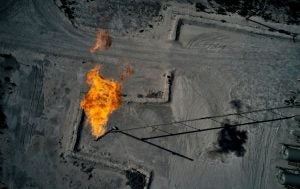As nations sign on to end routine flaring, Biden admin must act
 The last two months have seen encouraging momentum in the effort to tackle emissions of methane — a greenhouse gas that drives over a quarter of current warming — and the practice of flaring, which is a major source of energy waste and methane pollution.
The last two months have seen encouraging momentum in the effort to tackle emissions of methane — a greenhouse gas that drives over a quarter of current warming — and the practice of flaring, which is a major source of energy waste and methane pollution.
Starting with last month’s Major Economies Forum, one of the last major climate gatherings before COP 27 in Egypt, signatories to the Global Methane Pledge introduced a new goal to end routine flaring as soon as possible, and by 2030 at the latest.
Then, just this week, the U.S. and Mexico announced a commitment to cooperate and help Mexico develop a plan to eliminate routine flaring in alignment with the Global Methane Pledge.
Fast action to end routine flaring is critical for reducing emissions of methane, protecting human health and the climate, and stopping needless waste of energy resources as the world faces an energy crisis spurred by Russia’s invasion of Ukraine.
Now, the U.S. has work to do to ensure domestic policies can live up to our own global commitments. Fortunately, both the Bureau of Land Management and the Environmental Protection Agency have the authority and obligation to implement strong rules that end routine flaring.
The flaring problem
The practice of routine flaring represents an unchecked source of wasted resources and pollution.
Studies have shown that flaring is a major source of methane emissions, in addition to an array of other pollutants that harm human health and degrade air quality. Research conducted by EDF in the Permian Basin, the nation’s largest oilfield, repeatedly found that roughly 10% of flares are either malfunctioning or entirely unlit. As a result, these flares are spewing methane pollution directly into the atmosphere (see what that looks like here).
As nations sign on to end routine flaring, Biden admin must act Share on XThis pollution has a direct impact on nearby communities, and a recent peer-reviewed study underscores that many of the communities most impacted by oil and gas pollution are historically marginalized.
Additionally, the practice of routine flaring is a major source of wasted energy resources, with Energy Information Administration data indicating that the U.S. wastes roughly $1 billion of gas at flares each year. As consumers contend with high energy costs and Europe faces down an energy crisis spurred by Russia’s invasion of Ukraine, stopping this waste represents a dual climate and energy security win.
President Biden himself remarked that “climate security and energy security go hand in hand,” and added that “by stopping the leaking and flaring of the super potent greenhouse gas and capturing this resource for countries that need it, we’re addressing two problems at once.”
In fact, EDF analysis has shown that comprehensive efforts to curb methane emissions and end routine flaring in the U.S. alone could provide over half of the gas the Biden administration has committed to Europe.
Meanwhile, on public lands in the U.S., where the Bureau of Land Management is responsible for stewarding resources in the public’s interest, over $400 million of gas is flared off annually. That translates to $50 million in lost revenue that would otherwise go to supporting priorities like education and local infrastructure.
Policy solutions
The good news is that both EPA and BLM are advancing rules with the potential to end routine flaring. By quickly enacting standards that require commonsense solutions, these agencies can protect public health, stop unnecessary energy waste and safeguard both our climate and energy security — all while living up to our global commitments.
Analysis from Rystad Energy has found that solutions for operators to address flaring and capture this otherwise wasted gas are both readily available and cost-effective, and in many cases even profitable.
It’s no wonder that we’ve seen an array of oil and gas operators commit to end routine flaring. To name a few: ExxonMobil has committed to end routine flaring across its assets in the Permian Basin by 2022, BP has committed to end routine flaring by 2025 in its U.S. onshore operations, while many more have signed on to the World Bank’s goal of ending routine flaring worldwide by 2030.
The federal government should also look to the example of major energy producing states like Colorado and New Mexico, which have both moved to end the practice of routine flaring and have demonstrated how practical and achievable such action can be.
EPA and BLM can and must build on this example to protect communities across the country, put an end to needless waste and uphold our global commitments as we urge other nations to do the same.










